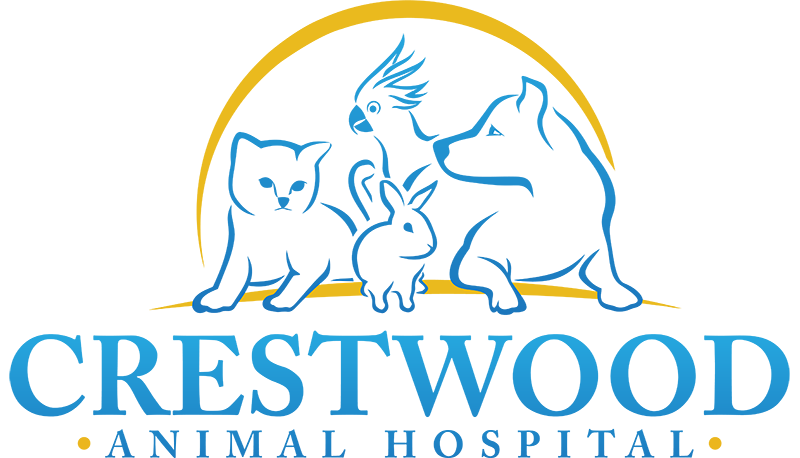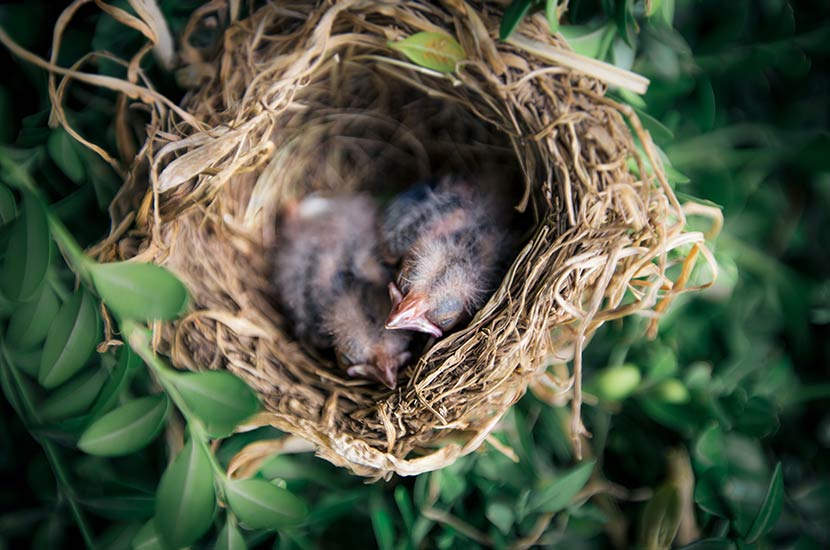Baby starlings and sparrows are a challenge to take care of. If you happen to find a baby starling or sparrow (or a baby bird in general) and do not know what to do follow the below rules:
- If the bird does not have any signs of injuries, bites, or other illnesses, please return a baby bird to the nest where it came from if possible. It is an old wives’ tale that birds will not accept their young if they babies leave the nest and protection of their mother or if they have been touched by a human. If the mom does not return to the next right away do not worry- she is likely looking for food to give to her babies.
- If the bird is completely feathered and you cannot find its nest, please place the fledgling in a bush or tree limb. Keep any cats indoors because it is likely the young bird is learning to fly. Ask the neighbors to do the same for the next few days.
- If the bird does appear injured, please drop the bird off at a wildlife clinic. Baby birds cannot be managed without proper medicine such as antibiotics and pain medicines.
Taking care of a baby starling or a baby sparrow is very time and labor intensive. We recommend that you take the baby bird to a wildlife clinic or a wildlife center. Please call the rehabber or wildlife facility first to check and see if these species are accepted, as some facilities will not take species that are not native to Illinois (sparrows and starlings both are invasive species).
If you want to raise the baby bird to become your family pet then observe the following instructions.
Baby birds need to be placed in a small container such as a margarine tub with paper towels crinkled inside to create a “nest”. This container needs to be placed on a heat pad and the temperature must be specific for the age and appearance of the bird and the baby’s requirements. New featherless babies need the temperature at 90° F. Baby birds with pin feathers should have a temperature of 85°F for their environmental temperature, and baby birds with a full set of feathers should be in a “nest” with the heating pad temperature set at 75° Fahrenheit.
With baby birds, dehydration is an issue. Do not give any baby birds fluids directly into the mouth because it can cause pneumonia. Pneumonia is caused because fluids are often accidentally sucked into the lungs of the bird instead of the esophagus. To help fight dehydration, offer instead small slivers of fruit, pieces of bread with a special liquid added to it (see below for liquid; squeeze the bread out to remove any excessive liquid), or apply a small drop or two of the liquid to the top of the beak. A good liquid solution to help with dehydration is ¼ cup Karo syrup, 1 cup water, and a pinch of salt. This concoction is boiled and then brought to room temperature so it is not hot or cold for the baby. **I could only find this, Gatorade, or 1 pinch salt and 1 pinch sugar in 1 cup of water as solutions to help rehydrate a baby. The rest recommend a rehabilitator
Starlings and sparrows are omnivores that require high levels of animal proteins. Baby starlings do not want liquid food, rather, they need solid foods. Typically in the wild, they are fed insects by the parents until they become fully grown. Parrot formulas are not appropriate for this type of bird. Starlings and Sparrows require 33.1% protein and 12.1% fat. Feeding the birds a dog or cat food with chicken as the primary ingredient and the above percentage requirements works best for feeding the babies. A good handfeeding formula for sparrows, starlings, and other omnivorous passerines is as follows:
1 cup soaked cat food (12.1% fat, 33.1% protein)
¼ cup applesauce
1 hard boiled egg
Avian vitamins
750 mg calcium (tums smooth dissolve tablets work) ground to a powder and dissolved in water
To feed baby birds, feed the birds with something flat such as a coffee stirrer, chop sticks, or a straw with the cut end such that it makes a scoop. Do not use something small like a Q-tip or a toothpick as these can be swallowed by the baby birds. When the food is fed, it should be at room temperature. The age of the bird determines the frequency the bird should be fed. Birds without any feathers should be fed every 30 minutes over 12 hours a day. Birds that have pin feathers or are developing feathers should be fed every 45 minutes (although they can occasionally go 1-2 hours without food if they show signs of disinterest at these feedings. When offering food, tap the top of the baby bird’s beak lightly. This should stimulate a feeding response, where the baby bird opens its mouth and begins begging. The baby birds may not initially beg for you to feed because they are not used to human feedings. However, once they adjust to this they should be begging at each feeding. Please do not ever feed any sort of worm to a baby bird as worms could have parasites that could have deadly consequences for babies. At 4 weeks of age, you can begin leaving food in a bowl in the cage for the baby birds. This will help them learn how to eat on their own. Continue to hand feed, however hand feed a little less during the feedings to help encourage eating on their own. When reducing the frequency of feedings, this should be done slowly and the baby birds’ weights must be monitored. You will still need to handfeed until somewhere around 6-8 weeks of age (varies from bird to bird)- you may need to continue handfeeding even longer. You will know when to stop handfeeding because the baby bird will be eating out of the bowl of food regularly and prefer to feed itself from the dish than from your handfed meals. Once birds are eating on their own for 3 weeks, they can be switched to an adult starling diet. Below is a rough timeline of the growth of baby starlings and sparrows
18 days- first drink or bath
21 days- beginning to fly
4-7 weeks old- eats from a bowl of food or the ground
8 weeks- begins to mold for the first time
20 weeks- develops a full grown adult set of feathers
15-30 weeks- starlings begin talking
For birds that will become family pets, you may offer them toys. They like toys that can be thrown around and toys that are shiny. Your pet bird should be exposed to natural sunlight on a daily basis unless the weather becomes too cold.
If you are raising a bird for release, the diet still should be the same as for pet birds, which is listed above. The only difference between raising a bird for release and a bird for a family pet is the frequency of handling the bird. If you plan on releasing the bird, do no handle unless absolutely necessary. Also, do not let pets or family members interact with the bird. We recommend giving any birds you find that appear ill to a rehabber, and any healthy birds are recommended to be returned to their nest or a bush depending on their appearance. Once birds that are destined for release have grown, you will need a large enclosure for the birds to practice free flight as well as exposing these birds to their species’ bird calls. If you have found just one baby bird, you will NEED to give it to a wildlife rehabber. A single baby bird cannot be raised without the bird imprinting on its caretaker, which makes the bird tame. A tame bird has very low chances of surviving in the wild.
What is imprinting? During a critical period of time early in life of a young bird, the bird develops a sense of identification. All courtship, mating, and species-directed behavior is directed towards that class of subspecies and is irreversible. If you have a bird imprint upon you, this bird can never be released into the wild as it will consider itself to be a human, not a bird and will attempt to mate with humans. This is why if someone finds one bird it must be sent to a rehabber or become a domesticated house bird. Because, if it only sees a human that feeds it, it will assume it is human as well. Unlike imprinting, taming a bird is socializing it to humans. This is reversible, but it requires a lot of work. The bird will not exhibit species specific behaviors such as courtship will humans should it become tame. If an animal acts tame, sometimes it cannot be released. Taming can potentially be reversible.
For many reasons, baby starlings and sparrows ought to be rehabilitated by a wildlife facility. Please check with local rehabbers to see if they accept baby sparrows and starlings. The above suggestions are for owners who plan to make the starling or sparrow a family pet. Should you plan to make this bird a family pet, we recommend a veterinary visit to ensure your bird is healthy.
A common baby starling problem is that mites may infect them. The mites are species specific and therefore will not cause harm to any other bird in your life. However, it has been indicated that there is a mite infection, we treat these mites.
We would like to do a physical examination to verify that mites and all other health issues are taken care of to ensure your new pet is healthy.

